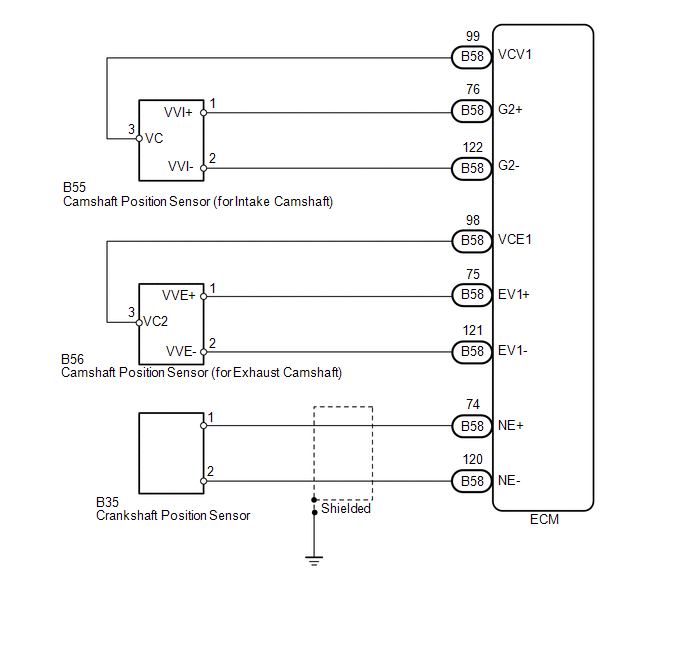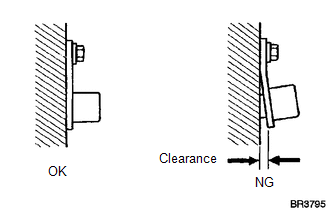Toyota Venza: Crankshaft Position Sensor "A" Circuit (P0335,P0339)
DESCRIPTION
The crankshaft position sensor system consists of a crank angle sensor plate and a pickup coil.
The sensor plate has 34 teeth and is installed on the crankshaft. The pickup coil is made of wound copper wire, an iron core and magnet. The sensor plate rotates and, as each tooth passes by the pickup coil, a pulse signal is created. The pickup coil generates 34 signals per crankshaft revolution. Based on these signals, the ECM calculates the crankshaft position and engine speed. Using these calculations, the fuel injection time and ignition timing are controlled.
|
DTC No. |
DTC Detection Condition |
Trouble Area |
|---|---|---|
|
P0335 |
One of the following condition is met (1 trip detection logic):
|
|
|
P0339 |
All of the following conditions are met (1 trip detection logic): (a) The engine speed is 1000 rpm or more. (b) No crankshaft position sensor signal for 0.05 seconds or more. (c) 3 seconds or more have elapsed since the starter signal switched from ON to OFF. |
|
- Reference: Inspection using an oscilloscope.
.png)
HINT:
Grounding failure of the shielded wire may cause noise in waveforms.
Terminal No. (Symbol)
Tool Setting
Condition
B58-74 (NE+) - B58-120 (NE-)
5 V/DIV, 20 ms/DIV
Idling
MONITOR DESCRIPTION
If there is no signal from the crankshaft position sensor despite the crankshaft revolving, the ECM interprets this as a malfunction of the sensor.
MONITOR STRATEGY
|
Related DTCs |
P0335: Crankshaft Position Sensor Range Check/Rationality P0335: Crankshaft Position Sensor Verify Pulse Input |
|
Required Sensors/Components (Main) |
Crankshaft position sensor |
|
Required Sensors/Components (Related) |
Camshaft position sensor |
|
Frequency of Operation |
Continuous |
|
Duration |
-: Verify pulse input case 1 4.7 seconds: Verify pulse input case 2 0.016 seconds: Range check/rationality |
|
MIL Operation |
Immediate |
|
Sequence of Operation |
None |
TYPICAL ENABLING CONDITIONS
P0335: Crankshaft Position Sensor Range Check/Rationality|
Monitor runs whenever the following DTCs are not stored |
None |
|
All of the following conditions are met |
- |
|
Time after starter OFF to ON |
3 seconds or more |
|
Number of camshaft position sensor signal pulses |
6 times |
|
Battery voltage |
7 V or higher |
|
Minimum battery voltage while starter ON |
Below 11 V |
|
Camshaft position sensor circuit fail |
Not detected |
|
Monitor runs whenever the following DTCs are not stored |
None |
|
All of the following conditions are met |
- |
|
Starter |
OFF |
|
Engine speed |
600 rpm or more |
|
Time after starter ON to OFF |
3 seconds or more |
|
Monitor runs whenever the following DTCs are not stored |
None |
|
Both of the following conditions are met |
- |
|
Starter |
ON |
|
Minimum battery voltage while starter ON |
Below 11 V |
TYPICAL MALFUNCTION THRESHOLDS
P0335: Crankshaft Position Sensor Range Check/Rationality|
Number of crankshaft position sensor signal pulses |
132 times or less, and 174 times or more |
|
Crankshaft position sensor signal |
No signal |
COMPONENT OPERATING RANGE
|
Crankshaft position sensor |
|
CONFIRMATION DRIVING PATTERN
- Connect the Techstream to the DLC3.
- Turn the ignition switch to ON and turn the Techstream on.
- Clear the DTCs (even if no DTCs are stored, perform the clear DTC procedure)
(See page
.gif) ).
). - Turn the ignition switch off and wait for at least 30 seconds.
- Turn the ignition switch to ON and turn the Techstream on.
- Start the engine.
- Idle the engine for 20 seconds or more [A].
- Enter the following menus: Powertrain / Engine / Trouble Codes [B].
- Read the Pending DTCs.
HINT:
- If a pending DTC is output, the system is malfunctioning.
- If a pending DTC is not output, perform the following procedure.
- Enter the following menus: Powertrain / Engine / Utility / All Readiness.
- Input the DTC: P0335 or P0339.
- Check the DTC judgment result.
Techstream Display
Description
NORMAL
- DTC judgment completed
- System normal
ABNORMAL
- DTC judgment completed
- System abnormal
INCOMPLETE
- DTC judgment not completed
- Perform driving pattern after confirming DTC enabling conditions
N/A
- Unable to perform DTC judgment
- Number of DTCs which do not fulfill DTC preconditions has reached ECU memory limit
HINT:
- If the judgment result shows NORMAL, the system is normal.
- If the judgment result shows ABNORMAL, the system has a malfunction.
- If the judgment result shows INCOMPLETE or N/A, perform steps [A] and [B] again.
- If no pending DTC is output, perform a universal trip and check for
permanent DTCs (See page
.gif) ).
).
HINT:
- If a permanent DTC is output, the system is malfunctioning.
- If no permanent DTC is output, the system is normal.
WIRING DIAGRAM

CAUTION / NOTICE / HINT
HINT:
- After performing the inspection procedure for the crankshaft position
sensor, if DTC P0335 is output again, check the following items related
to the camshaft position sensor.
- Installation condition of the camshaft position sensor
- Installation condition of the camshaft
- Connection of the camshaft position sensor connector
- If no problem is found through this diagnostic troubleshooting procedure, there may be a mechanical problem with the engine.
- Check the engine speed. The engine speed can be checked by using the
Techstream. To check, follow the procedure below:
- Connect the Techstream to the DLC3.
- Start the engine.
- Turn the Techstream on.
- Enter the following menus: Powertrain / Engine / Data List / Engine Speed.
- The engine speed may be indicated as zero despite the crankshaft revolving normally. This is caused by a lack of NE signals from the crankshaft position sensor. Alternatively, the engine speed may be indicated as less than the actual engine speed if the crankshaft position sensor output voltage is insufficient.
- Read freeze frame data using the Techstream. The ECM records vehicle and driving condition information as freeze frame data the moment a DTC is stored. When troubleshooting, freeze frame data can help determine if the vehicle was moving or stationary, if the engine was warmed up or not, if the air fuel ratio was lean or rich, and other data from the time the malfunction occurred.
PROCEDURE
|
1. |
READ VALUE USING TECHSTREAM (ENGINE SPEED) |
(a) Connect the Techstream to the DLC3.
(b) Turn the ignition switch to ON.
(c) Turn the Techstream on.
(d) Enter the following menus: Powertrain / Engine / Data List / Engine Speed.
(e) Start the engine.
(f) Read the values displayed on the Techstream while the engine is running.
OK:
Correct values are displayed.
HINT:
- To check the engine speed change, display the graph on the Techstream.
- If the engine does not start, check the engine speed while cranking.
- If the engine speed indicated on the Techstream remains at zero (0), there may be an open or short in the crankshaft position sensor circuit.
| OK | .gif) |
CHECK FOR INTERMITTENT PROBLEMS |
|
|
2. |
INSPECT CRANKSHAFT POSITION SENSOR (RESISTANCE) |
(a) Inspect the crankshaft position sensor (See page
.gif) ).
).
| NG | .gif) |
REPLACE CRANKSHAFT POSITION SENSOR |
|
|
3. |
CHECK HARNESS AND CONNECTOR (CRANKSHAFT POSITION SENSOR - ECM) |
(a) Disconnect the crankshaft position sensor connector.
(b) Disconnect the ECM connector.
(c) Measure the resistance according to the value(s) in the table below.
Standard Resistance (Check for Open):
|
Tester Connection |
Condition |
Specified Condition |
|---|---|---|
|
B35-1 - B58-74 (NE+) |
Always |
Below 1 Ω |
|
B35-2 - B58-120 (NE-) |
Always |
Below 1 Ω |
Standard Resistance (Check for Short):
|
Tester Connection |
Condition |
Specified Condition |
|---|---|---|
|
B35-1 or B58-74 (NE+) - Body ground |
Always |
10 kΩ or higher |
|
B35-2 or B58-120 (NE-) - Body ground |
Always |
10 kΩ or higher |
| NG | .gif) |
REPAIR OR REPLACE HARNESS OR CONNECTOR |
|
|
4. |
CHECK SENSOR INSTALLATION (CRANKSHAFT POSITION SENSOR) |
|
(a) Check the crankshaft position sensor installation. OK: Sensor is installed correctly. |
|
| NG | .gif) |
SECURELY REINSTALL SENSOR |
|
|
5. |
INSPECT CRANKSHAFT (TEETH OF CRANK ANGLE SENSOR PLATE) |
(a) Check the teeth of the crank angle sensor plate.
OK:
Crank angle sensor plate does not have any cracks or deformation.
| OK | .gif) |
REPLACE ECM |
| NG | .gif) |
REPLACE CRANKSHAFT |
 Knock Sensor 1 Circuit Low Input (Bank 1 or Single Sensor) (P0327,P0328)
Knock Sensor 1 Circuit Low Input (Bank 1 or Single Sensor) (P0327,P0328)
DESCRIPTION
Flat-type knock sensors (non-resonant type) have structures that can detect vibrations
between approximately 5 and 15 kHz.
Knock sensors are fitted onto the engine block to detect engi ...
 Camshaft Position Sensor Circuit Malfunction (P0340,P0342,P0343)
Camshaft Position Sensor Circuit Malfunction (P0340,P0342,P0343)
DESCRIPTION
The camshaft position sensor (G signal sensor) for the intake camshaft consists
of a magnet and MRE (Magneto Resistance Element).
The camshaft has a timing rotor for the camshaft posit ...
Other materials about Toyota Venza:
Jam Protection Function does not Operate
DESCRIPTION
This symptom may occur for any of the windows.
The jam protection function operates within a specified range during the manual
up or auto up operation.
CAUTION / NOTICE / HINT
NOTICE:
The power window control system uses a multiplex ...
Cold Start Ignition Timing Performance (P050B)
DESCRIPTION
This monitor will run when the engine is started at an engine coolant temperature
of -10 to 50°C (14 to 122°F). The DTC is stored after the engine idles for 13
seconds (2 trip detection logic).
The DTC is designed to monitor the ignition ti ...
System Diagram
SYSTEM DIAGRAM
Communication Table
Transmitting ECU
Receiving ECU
Signal
Communication Method
Air Conditioning Control Assembly
Air Conditioning Amplifier Assembly
Rear windo ...
0.1588

.gif)
